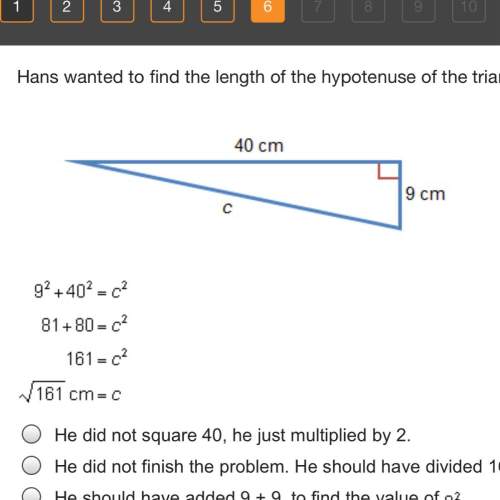
Mathematics, 01.07.2019 21:40 hibah2004
)determine if the divergence theorem can be used directly to find the flux of f = r r 2 where r = x i +y j +z k through the following surfaces. s1 is the cylindrical surface of radius 4 and length 10, centered at (6, 0, 0) with its axis parallel to the z-axis, oriented away from its axis. s2 is a sphere of radius 8 centered at the origin, oriented outward. s3 is a sphere of radius 5 centered at (7, 0, 0), oriented outward. s4 is the surface (x − 3)2 + (y − 2)2 + z2 = 16 , oriented outward. s5 is the boundary of the region y2 + z2 ≤ 16, −1 ≤ x ≤ 6 , oriented outward. s6 is the boundary of the region x2 + y2 ≤ 6, 1 ≤ z ≤ 10 , ori

Answers: 2
Another question on Mathematics


Mathematics, 21.06.2019 19:30
Write the sine and cosine values of a, b, respectively, in the figure for (1) and (2) + explanation.
Answers: 1

Mathematics, 21.06.2019 19:30
The total ticket sales for a high school basketball game were $2,260. the ticket price for students were $2.25 less than the adult ticket price. the number of adult tickets sold was 230, and the number of student tickets sold was 180. what was the price of an adult ticket?
Answers: 2

Mathematics, 21.06.2019 19:50
Examine the two-step equation. − 7 4 + x 4 = 2 which property of operations allows you to add the same constant term to both sides? amultiplication property of equality bdivision property of equality caddition property of equality dsubtraction property of equality
Answers: 2
You know the right answer?
)determine if the divergence theorem can be used directly to find the flux of f = r r 2 where r = x...
Questions

History, 19.03.2021 21:00

Mathematics, 19.03.2021 21:00

Mathematics, 19.03.2021 21:00




Mathematics, 19.03.2021 21:00


Social Studies, 19.03.2021 21:00


English, 19.03.2021 21:00

Mathematics, 19.03.2021 21:00

Mathematics, 19.03.2021 21:00




Mathematics, 19.03.2021 21:00

History, 19.03.2021 21:00





